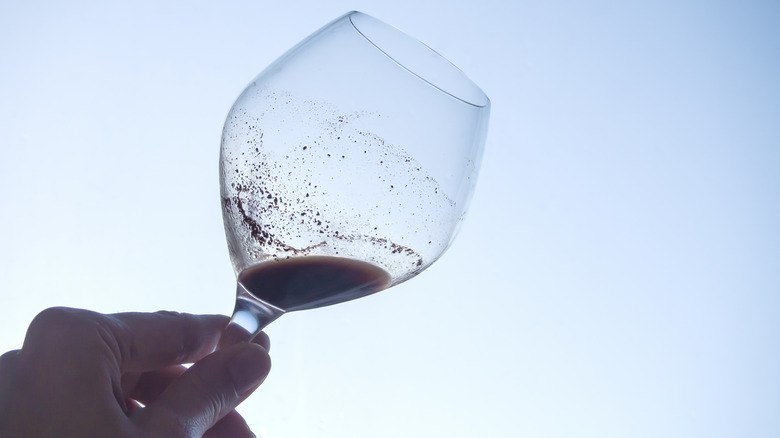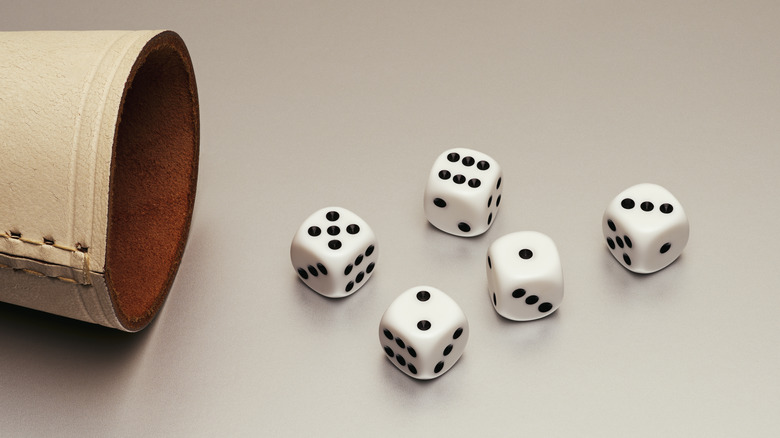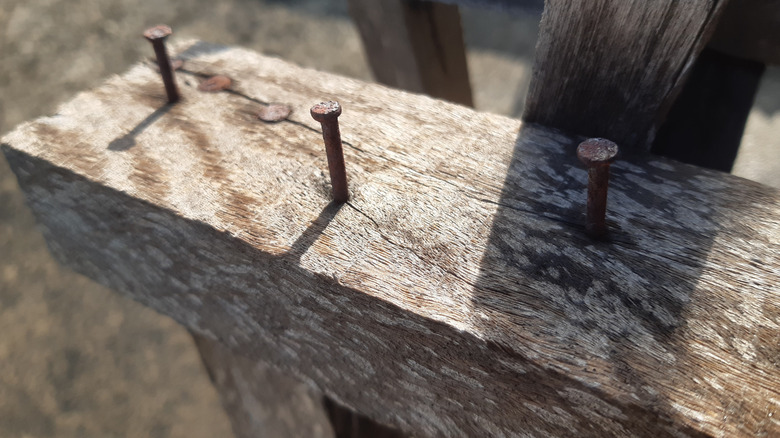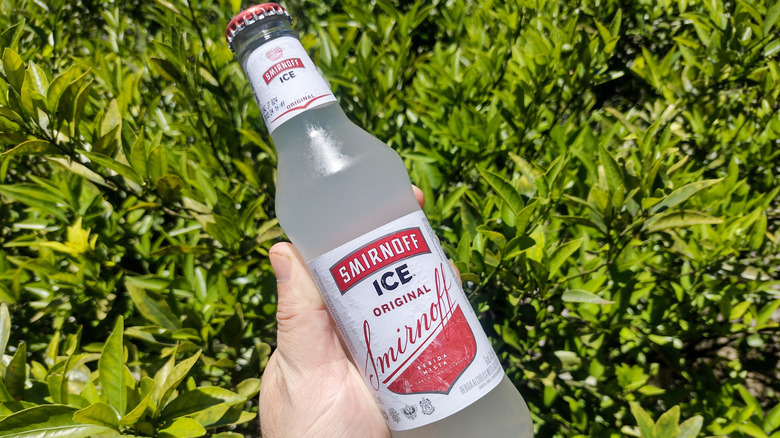13 Popular Drinking Games From Around The World
If your reaction to the winter months resembles ours, a refuge of stew recipes, weighted blankets, and bingeable series swaddle you during the abbreviated hours of sunlight and icy temperatures. But despite the mellow solaces of chilly weather, a yearning for the social interactions of summertime still persists during those frigid nights. Thankfully, the late-2024 hit single "APT." by Rosé — an ode to a Korean drinking game — can act as a seasonal affective disorder light when needed (while reminding us of other drinking games and warmer weather).
As inviting as a house you've crashed after partying, Rosé's chart-topper (featuring Bruno Mars) contains enough force to shock the summer out of anyone. Though the lyrics describe a raucous party, the song's inspiration cites an easy-to-learn game (known as ATP) where a group of friends stack their hands together, before someone calls out a number at random. Working from the bottom up, members of the hand-pile move their extremities to the top while counting to the number called. Whoever's hand ends up atop the heap at the end of the count loses, and takes a drink.
Of course, while ATP has littered the nation's bar culture (and TikTok) since Rosé's release, South Korea is hardly the only country with party tricks up its sleeve. Drinking games have existed nearly as long as imbibing itself , after all. To help ready you for a lifetime of socializing, here are 13 drinking games from around the globe to play (which should always be enjoyed responsibly).
Titanic (Korea)
Another friendly bout from South Korea, Titanic — which borrows its name from the 1912 disaster – asks its competitors to grab a not-quite-full glass of beer, a soju, a bottle, and a shot glass. Playable with as few as two players (but exciting with more), participants gather around the beer and carefully float the shot glass (hollow side up) in the vessel of beer.
Taking turns, players pour tiny amounts of soju into the buoyed glass, hoping the shot glass stays afloat. Whoever pours the fatal dose of soju — and causes the glass to sink to the beer's bottom — loses the game and must drink the contents. Essentially creating a somaek (or a quick cocktail of beer and soju), Titanic can easily be played at bars or at home. After all, it requires little more than a couple of delicious beverages and willing participants. Let the tension build over watching a puny glass waver in the amber waves of ale, and be ready to leave the match with a belly full of somaek.
Stairs (Russia)
A drinking game from Generation X's heyday, stairs can escalate quickly, so consider participating with a lower-ABV drink (or even spacing out the cups containing alcohol to keep players safe and the game running longer). Traditionally, the game utilizes Russia's national drink of choice in vodka, but substituting the clear liquid for any other spirit in a bottle will suffice. As the game's moniker implies, a staircase is required for this moderately perilous competition, and in Russia, players even take to the streets to contend in the light-hearted battle.
In the former Soviet country, typical staircases to the above floor consist of 18 steps broken up into two groups (each with nine steps). For each step taken, the players down a cap's worth of alcohol, and whichever player remains standing and sturdy the longest wins.
Interestingly, the game isn't devised to favor the quantity of booze players consume, but rather to take advantage of the body's mucus membrane absorbing both the alcohol content along with its vapors. This causes the spirit to reach the brain at a quicker pace without consuming a greater-than-necessary volume of alcohol in the process.
Hashiken (Japan)
Possibly harkening back to as early as 1849, Japan still holds hashiken tournaments in the 21st century. Hashiken originated in the Kochi prefecture, and only requires two players, six chopsticks, and a beverage. Before beginning, each player receives three chopsticks a piece, after determining which player starts the bout — often settled by a sub-game of paper, scissors, rock (or janken in Japanese).
The first player (or loser of janken) hides any number of the utensils behind their back. Concealed by their forearm, player one then reveals their chosen number of chopsticks by rotating their arm toward the ceiling. Simultaneously, player two selects a number of chopsticks, which they also shield with their forearm. After player one uncovers their chopsticks, their foe follows suit and twists their arm to expose their own set.
If the amount equals three, the second player wins the round, and the first player must drink. Otherwise, a rematch is held, and turns alternate until the second contestant can intuit their challenger's hand, with the total chopsticks equaling three. A relatively tame game compared to many on the list, several matches might play out before anyone takes a sip.
Caps (France)
Spatially more attuned for an outdoor setting, France's caps involve two sets of two players, each acting as a team. Sitting roughly 10 feet apart from one another, each team places a partially filled cup at their end, like a liquid goalpost. Similar to beer pong (but with one target instead of many), players from each team take turns attempting to toss bottle caps into the vessel near their adversary.
A player from each team rotates casting caps aimed at their opponent's cup until you reach a settled number of rounds, or one team simply taps out. A classic college game intended for beer, caps may be simple, but it holds the potentiality of a serious hangover if a player possesses extremely good hand-eye coordination. Consequently, swapping teammates every few rounds can even out the damage if one team has a ringer in their midst.
Shot potato (Ireland)
As its title suggests, Ireland's shot potato riffs on the classic children's birthday party game, hot potato — with the addition of shots. All you need is America's favorite root vegetable, a group, and a bottle of some sort of booze that everyone agrees on.
While music plays, players stand in a circle. Whoever is holding the potato at the start states the name of the person they'd like to toss the potato to, then does so, with the game continuing until someone makes a mistake. Though the game is incredibly simple, don't underestimate the variable of nerves mixed with booze. Either way, if (and when) a member of the circle drops the potato, flubs a name, or is caught with the potato in hand as the song ends, they lose that round of shot potato, and must take a drink.
The game continues until only one lonely — and sober — member remains, therefore winning. To have the game move faster (and increase the levels of excitement), consider selecting a partygoer to sit a round out each game to man the playlist. This way, the tune can be stopped at random while keeping shot potato chugging along.
Passatella (Italy)
A game predating the bar culture of today, Italy's passatella actually dates back centuries. It involves a group of participants pooling their money with each one receiving a drink. Two leaders of the game are chosen from the crowd: One deemed the boss, with the other named the game's underboss.
At the game's opening moment, both the boss and underboss toss back their drinks, leaving the remaining beverages untouched by the other participants. The boss either rules the game in communal fairness, or like a power-tripping dictator. After all, they possess the power to refuse specific members of the game their rightful drink and can swipe any player's drink for themselves. Similarly, even if the boss grants permission for a member to imbibe, the underboss may object, and the boss must finish the drink instead.
Not a game of physical skill, mindfulness, or manipulation, passatella plays off of the human urge to cajole and cause friction. While many bouts might result in every participant constantly drinking the drink they paid for, other outcomes ask the boss to drink all of the beverages in play.
Kottabos (Greece)
A game fit for natural wine enthusiasts, Greece's kottabos asks players to fling the sediment of a wine glass at a target — often a pole balancing a plate, but other times bronze disc called a plastinx. Now, the player who strikes the plate with enough force to knock it from its rod wins the game. But instead of triggering the opposing team to take a drink, whoever hits the designated target with their dregs of wine wins the prize.
Additionally, because of its messy nature, kottabos fits a casual, outdoor setting. This way, nothing valuable could get hit with a stray slosh of wine, players can spread out, and the grass and dirt absorb all the maroon damage. Depicted in ancient Greek art, Kottabos is widely thought to be the oldest known drinking game, proving the urge to combine competition with social drinking predates the party games of fraternity culture, red Solo cups, and stray ping pong balls.
Goon of fortune (Australia)
Also referred to as wheel of goon, Australia's drinking game requires a yard large enough to spread out, a hills-hoist clothing line, and several boxes of wine (another Australian invention). Though derogatory in many connotations, the so-called "goon" of this game refers only to points out the cheap nature of wine that hangs from one end of a four-tipped clothing line during play.
Like an aerial spin-the-bottle, a group of four players stand below a rotating, quad-tipped clothing rack. One of the participants then spins the suspended frame until it halts in front of the four players. Whoever the wine bag rests nearest to takes a slug of wine from the dangling pouch. An ideal way to add an extra bit of flare to a summer cookout, goon of fortune is undoubtedly messy. With that in mind, perhaps you should consider packing a change of clothes or a swimsuit if planning to play this action-packed drinking game.
Czółko (Poland)
A game recognizable to U.S. party-goers as heads up or the forehead game, Poland's czółko also asks willing participants to write a well-known person's name on a sticky note or adhesive nametag. Then, without revealing who it is, players must fasten the paper to the forehead of their neighbor to the right. The entire group follows suit, and members of the game take turns inquiring over the name taped to their forehead.
Using only yes or no questions, players narrow down the name, eventually guessing what celebrity they have scribed above their brow (as their friends snigger and giggle at their attempts). If a participant gets a no for an answer, they must take a sip of their drink; conversely, if they get a yes, they're one step closer to solving the riddle. So popular, a Polish app even simplifies the setup and transforms players' iPhones into electronic sticky notes, they each display over their sightline the game remains one of the only matches enjoyable sans alcohol since the gameplay itself proves entertaining enough without liquid courage.
Liar's game (China)
Sort of like Yahtzee meets poker, liar's dice (or chui niu) requires players to have on hand both a cup and five six-sided dice — enough for every member playing. Though liar's dice can function as a two-player game, more participants heightens the tension. Each player starts by rolling all five dice without revealing their count to any opponents, exercising caution to shield their results.
Each roller states how many of every value represented on a dice (up to six) they believe is represented throughout the table, starting from the lowest digits before working up to sixes by the end of the game. The next player to guess must place a higher bid than the person before them until someone brave enough calls the bluff and all the table's dice are revealed. Essentially, players speculate how many players rolled each number on a dice, from one to six. If the member who called out the guess is correct, or the final count is even higher, the person who vocally doubted the estimation must drink. In turn, if the bluff-caller is correct and the number is lower, the player who questioned the guess must drink.
While it may initially seem confusing, within a couple of rounds, a rhythm (as well as pressure) builds in liar's dice. Once it does, you're sure to enjoy a game that fuses mathematical probability, manipulation, and skill.
Hammerschlagen (Germany)
A game that should come with a warning label, hammerschlagen combines the contents of a toolbox with social drinking. Using a plank set roughly at waist level, each player is assigned a nail, which has been just slightly driven into a slab of wood or stump. Players then take turns lifting a hammer above their heads, attempting to hit any of their opponent's nails to drive them deeper into the piece of wood.
Anyone who misses their intended nail during their turn must take a drink, increasing the difficulty of the game as more and more players miss their mark (and become hindered by alcohol's effects). As you may have expected, the player with the last nail still sticking above the stump's surface wins. Despite its apparent risks, the popularity of the physical game has persisted through the years, and was even featured on an episode of "The Jimmy Fallon Show" in 2010.
Pub golf (Great Britian)
A drinking game that's capable of stimulating your local economy (as well as your ability to traverse a neighborhood while inebriated), England's pub golf — known as pub crawls in the U.S. — maps out several watering holes before the game's commencement. A great way to get chummy with your local barkeeps or introduce your part of town to newbies or visitors, pub golf plots out destinations (or holes) for your team before setting out to toss a drink back at each stop.
Participants race to complete the list of taverns before their competitors, and sometimes add an extra layer of embarrassment by selecting coordinating outfits to wear while gallivanting throughout the city (though this isn't necessary). Obviously, this is the type of skirmish intended for non-vehicular travel, meaning pub golf gets your body moving and your mind racing. While other house-based party games might tempt players to sink into a soft couch, pub golf ensures movement to assist in the metabolization of your night's drinks.
Icing (US)
Finally: A drinking game from our home country of the U.S. in icing. The beauty behind icing lies in its power to force an unassuming friend to submit the game's simple logic — without formally announcing the game's commencement. Almost an unspoken American tradition for anyone familiar with Smirnoff Ice or its many flavors, one partygoer hides a bottle of the malt beverage in a location likely traversed by someone else at the party. This could be a kitchen cabinet, couch cushions, even a target's personal bag.
When an unexpecting partygoer discovers the murky white bottle, they're subjected to drink the burp-inducing liquid ... or face the shame of being named a party-pooper. A staple of (21+) sleepovers, jovial dinner parties, and barbecues, the most effective games of icing refuse the ambiance of an all-out rager. Rather, they favor a more laid-back setting, where the juxtaposition between Smirnoff Ice's low-brow connotation and the sophistication of an adult get-together is heightened for the starkest contrast.













